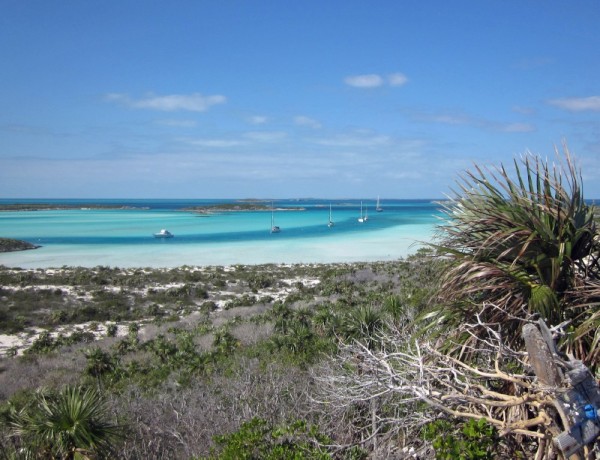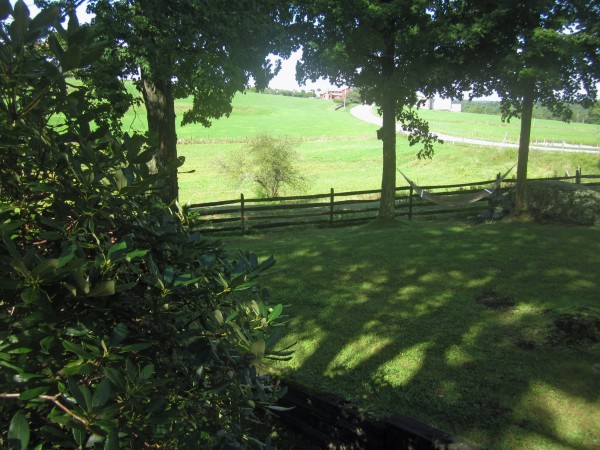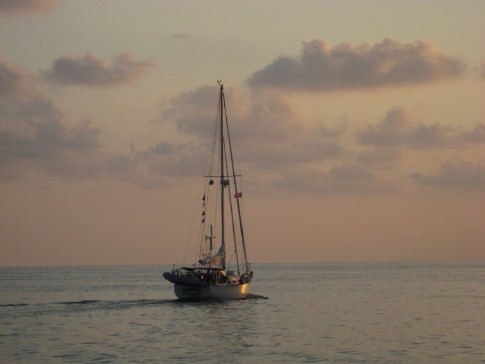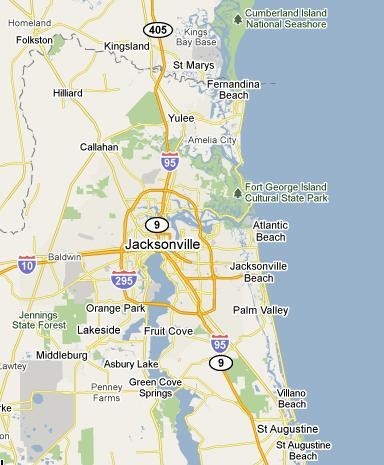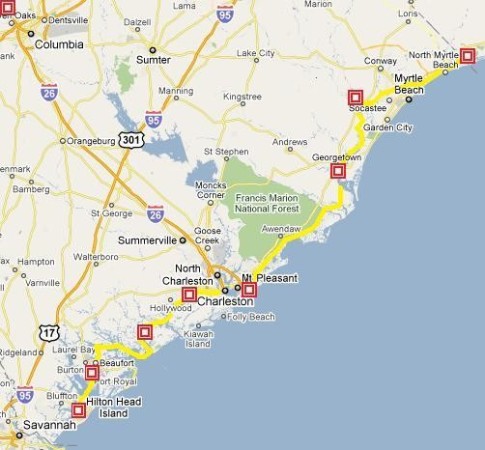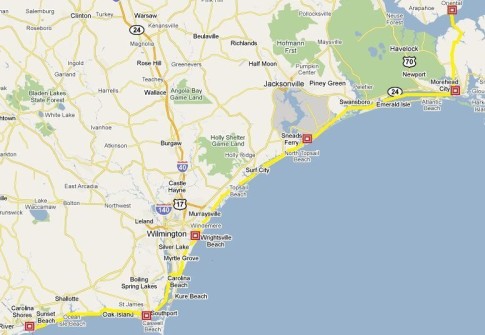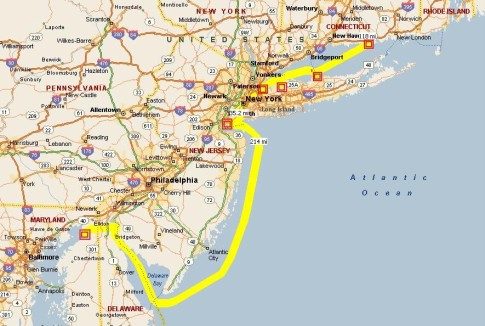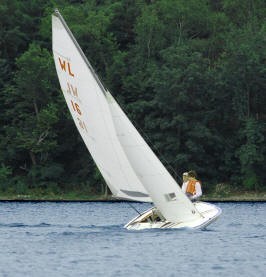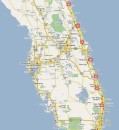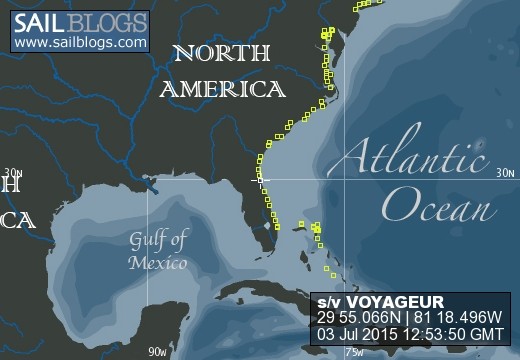
WELCOME ABOARD VOYAGEUR
11 July 2016
01 April 2016
28 November 2012
27 November 2012
26 November 2012
30 September 2011
28 August 2011
02 May 2011
16 April 2011
08 January 2011
12 November 2010
27 October 2010
24 September 2010
31 August 2010
18 May 2010
20 April 2010
27 August 2008 | Litchfield, CT
29 December 2007 | Litchfield, CT
Unions and Reunions
11 July 2016
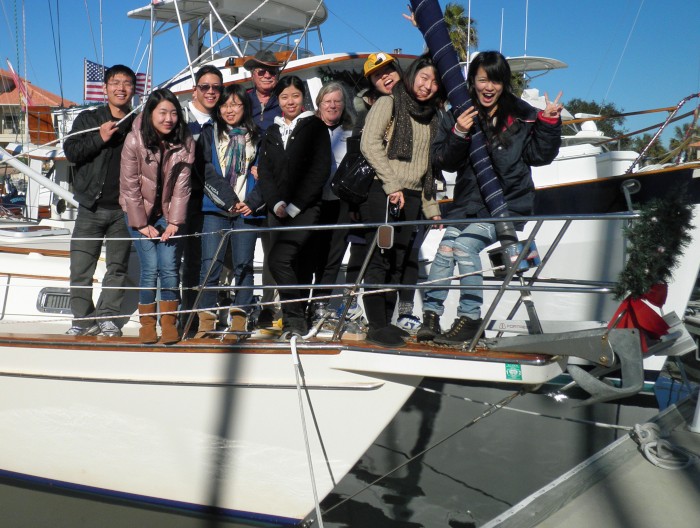
Since moving aboard Voyageur, Jane and I have spent the Christmas holidays berthed in St. Augustine. And every year since 2009, we have hosted a foreign college student for the mid-winter holiday fortnight. When their dorms and food facilities close, these students, introduced to us by an Atlanta organization called Christmas International House (CIH), would otherwise have had to return to their homes in Belarus, China, France, Yemen, Japan and India.
Our guest in 2010 was a young Chinese MBA student from the University of Michigan named Yizhou (Stephen) Xu. There were eight CIH students in town that year, all staying with families associated with Memorial Presbyterian Church. Among them, in addition to Stephen, a young Chinese woman and MBA candidate named "Lucky" Hu.
Over the years we have tried to stay in touch with our CIH friends from whom we learned so much about other places and cultures. From time to time we will see one of them as we travel aboard Voyageur or otherwise. In 2011 we met Stephen in New York and in 2014 we joined Lucky, now with Microsoft, for lunch in Dallas. In a few days we will fly to Maui for another CIH reunion. Stephen and Lucky have invited us to their wedding.
Our guest in 2010 was a young Chinese MBA student from the University of Michigan named Yizhou (Stephen) Xu. There were eight CIH students in town that year, all staying with families associated with Memorial Presbyterian Church. Among them, in addition to Stephen, a young Chinese woman and MBA candidate named "Lucky" Hu.
Over the years we have tried to stay in touch with our CIH friends from whom we learned so much about other places and cultures. From time to time we will see one of them as we travel aboard Voyageur or otherwise. In 2011 we met Stephen in New York and in 2014 we joined Lucky, now with Microsoft, for lunch in Dallas. In a few days we will fly to Maui for another CIH reunion. Stephen and Lucky have invited us to their wedding.
Rendezvous with Hokule'a
01 April 2016
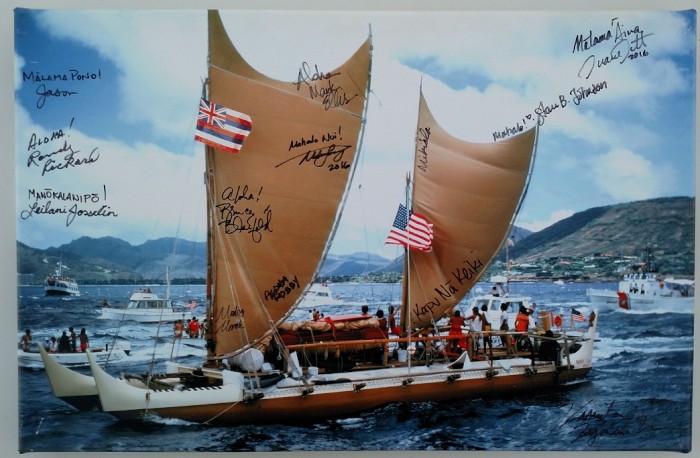
Jane's great uncle Ernest, a teacher, left Connecticut for Hawaii in 1914. During the years since then his descendants spread throughout the islands, many marrying native island inhabitants. In 1962 Jane visited Hawaii with her family on her 16th birthday and met many of her Hawaiian uncles, aunts and cousins. But she could not know then that she would have another such reunion more than 50 years later.
An unusual vessel spent the night of April 11, 2016 with us at Camachee Cove. Built and launched in Hawaii in 1975, Hokule'a, a Polynesian ocean sailing canoe, has crisscrossed the Pacific Ocean many times. In 1976, she made her maiden voyage from Maui to Tahiti and Jane's cousin David Lyman was among the crew. Another cousin Kimo was navigator on the the return trip and David and Kimo's sister, Mariane, was on yet another ! Currently on a round the world voyage, Hokule'a has among her crew a young Hawaiian by the name of Kaniela Lyman-Mersereau . . . who is also cousin to Jane.
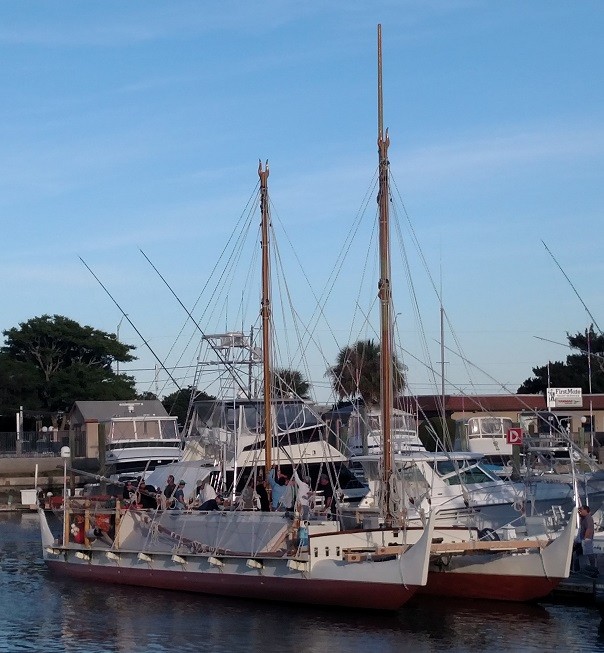
Because Jane, like Kaniela, had sailed thousands of miles to this unplanned family reunion, we thought it amazing that she would cross wakes with an Hawaiian cousin in St. Augustine's Camachee Cove Marina. But on reflection we supposed that it really wasn't so surprising since the sailing community, modest in number, shares a very small planet.
When her Uncle Ernest sailed to Hawaii more than one hundred years ago, he took to the sea to find a new life. And today his descendants Kaniela, Lyman, Kimo, Marian and his niece Jane are of one blood and the sea is in it.
An unusual vessel spent the night of April 11, 2016 with us at Camachee Cove. Built and launched in Hawaii in 1975, Hokule'a, a Polynesian ocean sailing canoe, has crisscrossed the Pacific Ocean many times. In 1976, she made her maiden voyage from Maui to Tahiti and Jane's cousin David Lyman was among the crew. Another cousin Kimo was navigator on the the return trip and David and Kimo's sister, Mariane, was on yet another ! Currently on a round the world voyage, Hokule'a has among her crew a young Hawaiian by the name of Kaniela Lyman-Mersereau . . . who is also cousin to Jane.

Because Jane, like Kaniela, had sailed thousands of miles to this unplanned family reunion, we thought it amazing that she would cross wakes with an Hawaiian cousin in St. Augustine's Camachee Cove Marina. But on reflection we supposed that it really wasn't so surprising since the sailing community, modest in number, shares a very small planet.
When her Uncle Ernest sailed to Hawaii more than one hundred years ago, he took to the sea to find a new life. And today his descendants Kaniela, Lyman, Kimo, Marian and his niece Jane are of one blood and the sea is in it.
After The Tour
28 November 2012
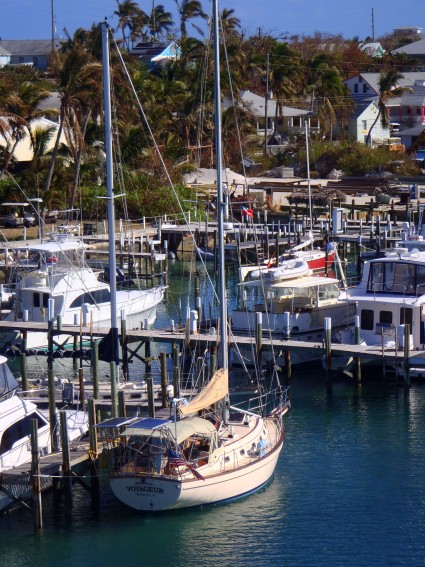
Jane's reflections since returning from the tour . . .
At 3:00 PM on Wednesday, November 14, 2012, after three and a half months visiting family and friends ashore, we stepped back on to Voyageur, our luggage and persons delivered to the boat by the Marsh Harbour to Man-O-War ferry. Darren Sands, the manager of Edwin's Boat Yard # 2 who watched our floating home for us through Hurricane Sandy, moved her from her mooring to his dock a few hours before we arrived. We thought Voyageur had ridden out the hurricane in the island's well protected South East mooring field but in fact she spent the last three and a half months on a mooring just off the Man-O-War town dock. More than one person told us "she rode beautifully through the storm . . . stayed upright and didn't wander too much from side-to-side." We later learned that three boats in the East field hadn't done as well and had broken from their moorings. Luckily, they found their way to a soft landing ashore without doing much damage to themselves or to other boats. One deserted boat near the town mooring field and not far from Voyageur pulled loose and drifted up high and dry onto the mangroves.
Before we arrived Darren washed off all the salt the storm deposited on Voyageur so she looked pretty good. Two bungees that quieted lines on the mast were gone. We had removed the genoa and smaller staysail and stored them below but left the mainsail on the boom. It and its new stow pack were unharmed. The only real damage on the boat was that sustained by the wind generator. Its propeller hub cracked in the 100mph+ winds and its bearings were damaged as well. It is only rated to 110 mph and may have seen more than that. Haven't yet determined if we will try to get it fixed here or wait until we get back to the States. Also, our dinghy's Yamaha outboard motor, which had been removed from Voyageur and stored in a shed ashore, lay submerged for two days. So we'll have to replace the outboard as well.
Before we left the boat in July we carefully stowed everything inside so we found the boat's interior largely un-disturbed. A few books fell from a book shelf and there was a very fine dust on everything inside the boat, even inside lockers and cabinets, which must have come through tiny spaces in portholes and hatches too small to allow water to enter. Only one port leaked a bit causing some mildew on our mattress cover and a couple of pillows. But it washed out. Not surprisingly, after being closed up for more than three months, mildew was beginning to appear in a few other places as well. As I write this, much of the inside of the boat has been thoroughly cleaned. It's slow going though.
When we got aboard, we found one problem unrelated to the storm. The boat's fresh water pump that supplies the galley and both heads wasn't working. It had a dead short in the motor's armature so we were without running water for a day before it was replaced. Schlepping water jugs from the grocery store is a lot of work! Thankfully, a friend loaned us her golf cart (there are no cars on Man-O-War) for a couple of grocery shopping trips.
The quiet settlement of Man-O-War fared pretty well through Sandy with no buildings destroyed. But many beaches on the ocean side of the cay were largely washed away while a few others were made larger. Some of the houses on the north end of the island were damaged by a six foot storm surge. Apparently, many of the islanders thought Sandy would be a tropical storm when it went by rather than the Category 2 hurricane that it turned out to be. So they waited to start preparing until less than twenty-four hours before the storm hit. It seems that a few boaters may have known more about the impending hurricane from their sources than did the locals. With the passage of Sandy's eye, which lasted 10-12 hours, many of the town's residents and boaters thought that the storm was over. So many folks went back to their boats, homes and businesses. But some boaters warned that more was coming and come it did. The west winds continued to blow at hurricane or tropical storm force for four days after the eye passed while the long tail of the storm lingered over the Abacos.
It was good to be back in touch with our friends here including cruisers and the permanent residents of Man-O-War. We've attended Sunday services, been to the Dock n' Dine restaurant a couple of times and enjoyed cocktails at a beach house owned by a young at heart 96-year old woman from Millbrook NY, invited by friends of hers we met on the ferry when you-know-who struck up a conversation with them. The days spent on Man-O-War have been sunny, about 75 degrees and the starry nights cool enough for our old friend Pluffy, a down comforter. We've been in shorts and sandals. It gets dark at 6:00 pm which is a different Bahamas experience for us as we have never been here at this time of year before. When another month passes and we reach the winter solstice, it will get dark even earlier.
We both put on a few pounds during the sofa tour and got even farther out of shape than we were when we left Voyageur. We are experiencing the usual aches and pains that accompany the transition back to life on the boat due to what some cruisers call "boat yoga". But we have a built-in stair stepper (going up and down the companionway between the boat's interior and her cockpit), plenty of bending getting in and out of lockers, heavy lifting putting up sails, re-shipping the anchor, etc. etc. It's all good exercise. And we have modified our diet as well . . . less cheese (it's too expensive here) and maybe a bit less alcohol and very little bread except what I'm going to make aboard
We stayed on Darren's dock for a few days which made it handy for provisioning and other shopping. But when we visited the two small grocery stores in town to pick up a few items we spent more than $250. So a few days later we motored five miles across the Sea of Abaco to tie up at the Jib Room in Marsh Harbour (the Marsh Harbour Marina really). Things should be bit less expensive here. It's a larger settlement and the commercial center of the Abacos. We will buy staples like flour, sugar, cereals, bread crumbs, pasta, rice and crackers in addition to fresh veggies, fruits, meats and dairy items. And we need to stock up on a lot of canned goods that we'll need for the more remote Exumas. I am expecting a huge outlay.
Of course we'll visit the Jib Room once or twice or maybe more. Their Wednesday night smoked rib dinners and Saturday night steaks are hard to resist.
Bob & Jane Fulton
Nov 2012
At 3:00 PM on Wednesday, November 14, 2012, after three and a half months visiting family and friends ashore, we stepped back on to Voyageur, our luggage and persons delivered to the boat by the Marsh Harbour to Man-O-War ferry. Darren Sands, the manager of Edwin's Boat Yard # 2 who watched our floating home for us through Hurricane Sandy, moved her from her mooring to his dock a few hours before we arrived. We thought Voyageur had ridden out the hurricane in the island's well protected South East mooring field but in fact she spent the last three and a half months on a mooring just off the Man-O-War town dock. More than one person told us "she rode beautifully through the storm . . . stayed upright and didn't wander too much from side-to-side." We later learned that three boats in the East field hadn't done as well and had broken from their moorings. Luckily, they found their way to a soft landing ashore without doing much damage to themselves or to other boats. One deserted boat near the town mooring field and not far from Voyageur pulled loose and drifted up high and dry onto the mangroves.
Before we arrived Darren washed off all the salt the storm deposited on Voyageur so she looked pretty good. Two bungees that quieted lines on the mast were gone. We had removed the genoa and smaller staysail and stored them below but left the mainsail on the boom. It and its new stow pack were unharmed. The only real damage on the boat was that sustained by the wind generator. Its propeller hub cracked in the 100mph+ winds and its bearings were damaged as well. It is only rated to 110 mph and may have seen more than that. Haven't yet determined if we will try to get it fixed here or wait until we get back to the States. Also, our dinghy's Yamaha outboard motor, which had been removed from Voyageur and stored in a shed ashore, lay submerged for two days. So we'll have to replace the outboard as well.
Before we left the boat in July we carefully stowed everything inside so we found the boat's interior largely un-disturbed. A few books fell from a book shelf and there was a very fine dust on everything inside the boat, even inside lockers and cabinets, which must have come through tiny spaces in portholes and hatches too small to allow water to enter. Only one port leaked a bit causing some mildew on our mattress cover and a couple of pillows. But it washed out. Not surprisingly, after being closed up for more than three months, mildew was beginning to appear in a few other places as well. As I write this, much of the inside of the boat has been thoroughly cleaned. It's slow going though.
When we got aboard, we found one problem unrelated to the storm. The boat's fresh water pump that supplies the galley and both heads wasn't working. It had a dead short in the motor's armature so we were without running water for a day before it was replaced. Schlepping water jugs from the grocery store is a lot of work! Thankfully, a friend loaned us her golf cart (there are no cars on Man-O-War) for a couple of grocery shopping trips.
The quiet settlement of Man-O-War fared pretty well through Sandy with no buildings destroyed. But many beaches on the ocean side of the cay were largely washed away while a few others were made larger. Some of the houses on the north end of the island were damaged by a six foot storm surge. Apparently, many of the islanders thought Sandy would be a tropical storm when it went by rather than the Category 2 hurricane that it turned out to be. So they waited to start preparing until less than twenty-four hours before the storm hit. It seems that a few boaters may have known more about the impending hurricane from their sources than did the locals. With the passage of Sandy's eye, which lasted 10-12 hours, many of the town's residents and boaters thought that the storm was over. So many folks went back to their boats, homes and businesses. But some boaters warned that more was coming and come it did. The west winds continued to blow at hurricane or tropical storm force for four days after the eye passed while the long tail of the storm lingered over the Abacos.
It was good to be back in touch with our friends here including cruisers and the permanent residents of Man-O-War. We've attended Sunday services, been to the Dock n' Dine restaurant a couple of times and enjoyed cocktails at a beach house owned by a young at heart 96-year old woman from Millbrook NY, invited by friends of hers we met on the ferry when you-know-who struck up a conversation with them. The days spent on Man-O-War have been sunny, about 75 degrees and the starry nights cool enough for our old friend Pluffy, a down comforter. We've been in shorts and sandals. It gets dark at 6:00 pm which is a different Bahamas experience for us as we have never been here at this time of year before. When another month passes and we reach the winter solstice, it will get dark even earlier.
We both put on a few pounds during the sofa tour and got even farther out of shape than we were when we left Voyageur. We are experiencing the usual aches and pains that accompany the transition back to life on the boat due to what some cruisers call "boat yoga". But we have a built-in stair stepper (going up and down the companionway between the boat's interior and her cockpit), plenty of bending getting in and out of lockers, heavy lifting putting up sails, re-shipping the anchor, etc. etc. It's all good exercise. And we have modified our diet as well . . . less cheese (it's too expensive here) and maybe a bit less alcohol and very little bread except what I'm going to make aboard
We stayed on Darren's dock for a few days which made it handy for provisioning and other shopping. But when we visited the two small grocery stores in town to pick up a few items we spent more than $250. So a few days later we motored five miles across the Sea of Abaco to tie up at the Jib Room in Marsh Harbour (the Marsh Harbour Marina really). Things should be bit less expensive here. It's a larger settlement and the commercial center of the Abacos. We will buy staples like flour, sugar, cereals, bread crumbs, pasta, rice and crackers in addition to fresh veggies, fruits, meats and dairy items. And we need to stock up on a lot of canned goods that we'll need for the more remote Exumas. I am expecting a huge outlay.
Of course we'll visit the Jib Room once or twice or maybe more. Their Wednesday night smoked rib dinners and Saturday night steaks are hard to resist.
Bob & Jane Fulton
Nov 2012
The Great Sofa Tour of 2012
27 November 2012
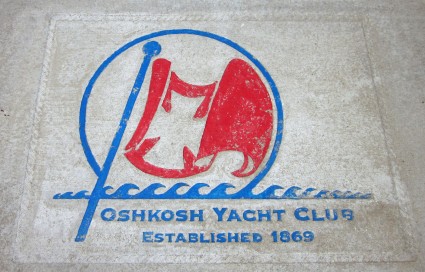
Coming Soon !
It's Been A Quiet Year Aboard Voyageur
26 November 2012
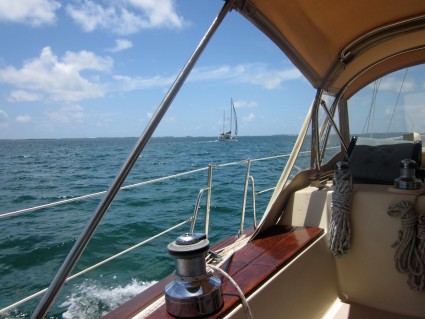
Dear Family and Friends ~
Bob: Well, it was a quiet year aboard Voyageur . . . from late September of 2011 until July 26, 2012. After feeling our way down the fog bound coast of New Jersey that September, we cruised Chesapeake Bay (where we were ambushed by a remarkably effective cruise telemarketer . . . more on that later) and visited the Annapolis Sailboat Show (where we were ambushed by a remarkably effective stainless steel arch salesperson . . . more on that later).
After leaving the Bay, Voyageur and crew worked their way down the Intracoastal Waterway from Norfolk, VA, to Southport, NC, and paused there for shrimp n' grits, worshiped with the town's remarkable Methodist congregation and looked carefully at the weather and sea condition forecast. A day or two later, due to big wind and waves offshore, we decided to stay on the inside and ultimately followed the Intracoastal Waterway all the way to Hilton Head Island.
Jane: ActualIy, I don't mind at all taking the inside route to Hilton Head. The trip from Charleston to Beaufort, SC, is one of my favorites on the Intracoastal because the waterway meanders from creek to creek through the beautiful and timeless South Carolina low country. It is quite remote, with few houses or docks or signs of life and only two bridges along the route, both 65-footers. Golden marsh grasses stretch along both sides with scattered pockets of trees.
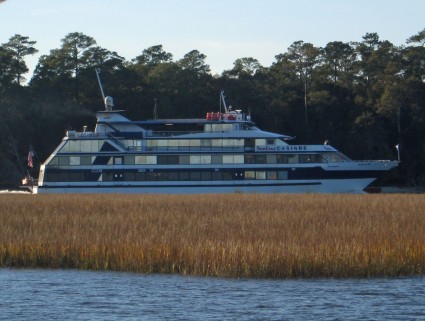
Sometimes, when we see shrimp boats or trawlers or sailboat masts over the grass, it looks like they are sailing through a golden sea.
The route is sometimes only five miles from the seacoast and at other times 20 miles inland. There are many good anchorages on side creeks or even in the main rivers out of the traffic channel. Tides are 5-6 feet and currents 1-2 knots, though somewhat stronger in the narrow cuts. We usually transit this 65-mile stretch in three or four leisurely days, moving when the tide is between half and full to have sufficient depth in the narrow land cuts between rivers. A fast motor yacht can do the stretch in a day but its crew will miss some of the joys of taking it slow.
Bob: I suspect they find joy in other things . . . like going by sailboats WAY too fast and WAY too close.
Jane: In this part of South Carolina, any piece of land that is surrounded on four sides by water in any form (river, creek or sound) is called an island. So the coast is a patchwork of islands, often with Indian names. And the names are quite unique to yankees like us.
The Ashley River takes us south out of Charleston harbor and turns west onto Wappoo Creek where there is a drawbridge that opens only at scheduled times. Once through the bridge we motor the short distance to Elliott's cut, a tricky half mile man-made cut with rocks on either shore and swift currents of four knots or more in either direction depending on tide. We've been through Elliott's at slack current, no big deal, and on other occasions going with or against a four knot current . . . challenging in either direction but always a fun ride! The cut takes us to the Stono River where we turn right to go upstream around John's Island. Here we are 18 miles from the sea at Kiawah Island.
Soon we're on Wadmalaw Sound, moving downstream on the Wadmalaw River, past Toogoodoo Creek, a good anchoring spot. The Wadmalaw becomes the North Edisto River which we follow for seven miles to a right, upstream turn onto the Dawho River which leads us to North Creek which leads us to the half-mile long Watts Cut which leads us to the wide South Edisto River. Here we turn downstream seven miles to Fenwick Cut across Fenwick Island, about five miles from Edisto Beach, SC. A right turn takes us upstream on the Ashepoo River toward the Ashepoo Coosaw cutoff across Hutchinson Island to another upstream turn onto Rock Creek to another Ashepoo-Coosaw cutoff to the Coosaw River, only three miles from St. Helena Sound and the coast.
To describe this section of the waterway accurately I'm looking at our charts while I type. But as I study the charts I seem to have a old spiritual song going through my head . . . the Wappoo connected to the Stono; the Stono connected to the Wadmalaw; the Wadmalaw connected to the Edisto; the Edisto connected to the Dawho; the Dawho connected to the Ashepoo; the Ashepoo connected to the Coosaw; now hear the word of the Lord.
Anyway, we follow the Coosaw eleven miles upstream around Coosaw Island, then take Brickyard Creek past a Marine Corps Air Station and on to the Beaufort (Bu'-fert) River that flows between Beaufort and Lady's Island. The Lady's Island drawbridge opens on the hour at 9, 10, 11, 1, 2, 3, and 4 o'clock so punctuality along this stretch of the waterway is important.
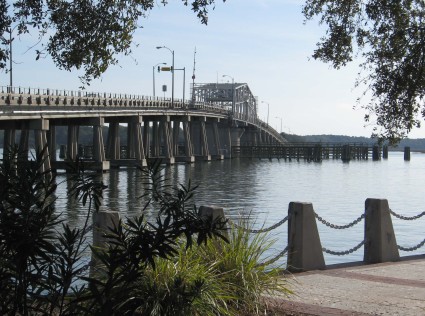
We spent a couple of days in Beaufort, enjoyed shrimp'n grits again, made some new friends and greeted some old ones and took Bob to a local clinic for a swollen bursa on his elbow. After they aspirated his elbow and we stuffed him with Cipro for a couple of days (which threw him for a loop) we left for Hilton Head Island and Shelter Cove Marina, a day down the waterway, where we spent some quality time with friend Linda on her Island Packet cutter MoDachaidh (mo-DOCK-ee).
Bob: On the warm afternoon of 20 November, 2011, we left Hilton Head and Daufuskie Islands astern and headed out Tybee Roads Inlet to the open ocean. Alternating three hour watches for the twenty-three hour, twenty-six minute run to St. Augustine Inlet whistle buoy, we both looked forward to a reunion with friends at Camachee Cove Yacht Harbor and Memorial Presbyterian Church. During our life aboard Voyageur, St. Augustine had become our second home.
Thanksgiving 2011 was one to remember. Friends Stu and Dorothy invited us to spend the day with their family enjoying a traditional Thanksgiving Low Country Boil . . . shrimp, sausage, corn on the cob, potatoes and crab legs together with appetizers and desserts of all kinds. . . washed down with a few of their famous "Pain Killers" A few days later, Jane took her tape measure on a tour of north Florida supermarkets and finally found the perfect turkey to roast in Voyageur's modest oven . . . fourteen inches long by seven inches tall and nearly rectangular in shape.
Advent and Christmas followed with all the blessings of the season including the annual bunch of wonderful international college students hosted by members of Memorial Presbyterian Church through a program called Christmas International House. Then we settled in for the winter. Until early February 2012, Voyageur and her crew lay in slip G15 spending quiet afternoons with her crew pouring over books and brochures about cruise ships of all sizes and colors and 2013 cruise itineraries that included the likes of the North Sea and the Baltic, the Mediterranean and Black Sea, and the Atlantic (which we subsequently chose) from Barcelona to New Orleans.
That decision in hand, we began to plan a September / October / November 2013 return trip to the UK including visits to London, Edinburgh and Stone before a three week narrow boat cruise on the midlands' Warwickshire Ring with friends John and Jackie from St. Augustine. Then we'll join twenty-six hundred of our closest friends in Barcelona to begin the Atlantic crossing which will take us to Mallorca and Malaga in Spain, Las Palmas in the Canary Islands and Grand Turk Island in the Bahamas before arriving in New Orleans. We live on a boat so . . . what do we do for vacation? We go boating. But I digress.
It was now early February and our impending return to the Bahamas in April was . . . well . . . impending, with much work to do before Voyageur was ready for the trip. On a cold, blustery winter morning she was gently nudged into a Camachee Cove yard slip at about the same time Jane and I were saying so long but not good bye to dear friend Stephen at Arlington Cemetery.
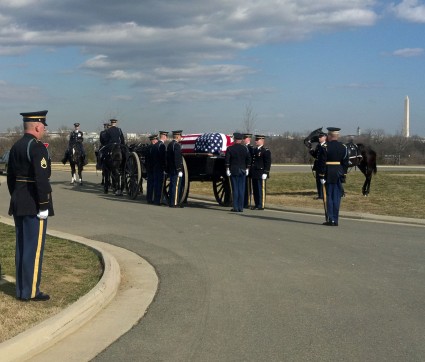
He and wife Sharon helped us realize our cruising dreams. They introduced us to friends and Island Packet single handers Alan and Linda aboard s/v Whisker and s/v MoDachaidh respectively with whom we visited the Bahamas for the first time in 2009.
Voyageur would have everything removed from her cockpit and stern to make way for installation of the stainless steel arch and solar panels we purchased in Annapolis the previous fall. And, like most projects Bob had ever been associated with, this one took WAY more time, effort and financial resources than was anticipated. The arch (some of our friends with rapier wit and a fondness for cheeseburgers refer to it as "the golden arch") and solar panels, controller and wiring took five weeks to install.
On March 16, with all refitting complete and friends John and Jackie aboard, Voyageur left St. Augustine and headed south.
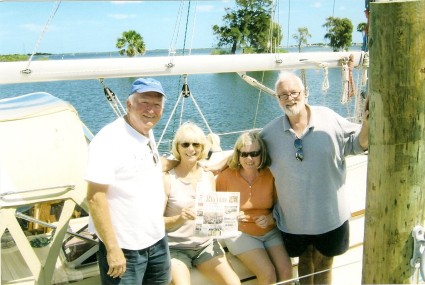
After dropping John and Jackie in Titusville, we kept moving further south to Lake Worth (West Palm Beach), our jumping off place for the islands. There we met two of Bob's high school classmates, Jay and Brian, and friends Jay and Susan from Litchfield, and made new friends Mark & Meridee aboard m/v Folie a Deux and Bill & Rosie aboard m/v Nexus.
On April 26 in an early morning mist we pulled the hook, left Peanut Island astern and headed east out the Lake Worth Inlet, bound for a sheltering, uninhabited anchorage called Great Sale Cay about eighteen hours away in the northern Bahamas. The passage was a quiet one with little or no wind to help our 50HP Yanmar diesel push us across the Gulf Stream. We dug the anchor into Little Bahama Bank at about 11:00 PM and pulled our down comforter over us for a short sleep, our first under Bahamian stars in two years.
The next morning we hauled the hook at "O Dark 30" and headed out into the Sea of Abaco. There, after breakfast and a couple of leisurely hours under sail headed for Green Turtle Cay, one of us said to the other, "Instead of going back to the states in a month or two, why don't we keep Voyageur in the Bahamas for a year?" After a bit of discussion, we agreed on the idea and for the next three months we cruised the Abacos before leaving Voyageur in Man-O-War Cay and flying to Miami.
And now you know the rest of the story. "The rest of what story?" . . . you may ask.
Well, it's the story of how the Great Sofa Tour of 2012 began.
Bob & Jane Fulton
November 2012
Bob: Well, it was a quiet year aboard Voyageur . . . from late September of 2011 until July 26, 2012. After feeling our way down the fog bound coast of New Jersey that September, we cruised Chesapeake Bay (where we were ambushed by a remarkably effective cruise telemarketer . . . more on that later) and visited the Annapolis Sailboat Show (where we were ambushed by a remarkably effective stainless steel arch salesperson . . . more on that later).
After leaving the Bay, Voyageur and crew worked their way down the Intracoastal Waterway from Norfolk, VA, to Southport, NC, and paused there for shrimp n' grits, worshiped with the town's remarkable Methodist congregation and looked carefully at the weather and sea condition forecast. A day or two later, due to big wind and waves offshore, we decided to stay on the inside and ultimately followed the Intracoastal Waterway all the way to Hilton Head Island.
Jane: ActualIy, I don't mind at all taking the inside route to Hilton Head. The trip from Charleston to Beaufort, SC, is one of my favorites on the Intracoastal because the waterway meanders from creek to creek through the beautiful and timeless South Carolina low country. It is quite remote, with few houses or docks or signs of life and only two bridges along the route, both 65-footers. Golden marsh grasses stretch along both sides with scattered pockets of trees.

Sometimes, when we see shrimp boats or trawlers or sailboat masts over the grass, it looks like they are sailing through a golden sea.
The route is sometimes only five miles from the seacoast and at other times 20 miles inland. There are many good anchorages on side creeks or even in the main rivers out of the traffic channel. Tides are 5-6 feet and currents 1-2 knots, though somewhat stronger in the narrow cuts. We usually transit this 65-mile stretch in three or four leisurely days, moving when the tide is between half and full to have sufficient depth in the narrow land cuts between rivers. A fast motor yacht can do the stretch in a day but its crew will miss some of the joys of taking it slow.
Bob: I suspect they find joy in other things . . . like going by sailboats WAY too fast and WAY too close.
Jane: In this part of South Carolina, any piece of land that is surrounded on four sides by water in any form (river, creek or sound) is called an island. So the coast is a patchwork of islands, often with Indian names. And the names are quite unique to yankees like us.
The Ashley River takes us south out of Charleston harbor and turns west onto Wappoo Creek where there is a drawbridge that opens only at scheduled times. Once through the bridge we motor the short distance to Elliott's cut, a tricky half mile man-made cut with rocks on either shore and swift currents of four knots or more in either direction depending on tide. We've been through Elliott's at slack current, no big deal, and on other occasions going with or against a four knot current . . . challenging in either direction but always a fun ride! The cut takes us to the Stono River where we turn right to go upstream around John's Island. Here we are 18 miles from the sea at Kiawah Island.
Soon we're on Wadmalaw Sound, moving downstream on the Wadmalaw River, past Toogoodoo Creek, a good anchoring spot. The Wadmalaw becomes the North Edisto River which we follow for seven miles to a right, upstream turn onto the Dawho River which leads us to North Creek which leads us to the half-mile long Watts Cut which leads us to the wide South Edisto River. Here we turn downstream seven miles to Fenwick Cut across Fenwick Island, about five miles from Edisto Beach, SC. A right turn takes us upstream on the Ashepoo River toward the Ashepoo Coosaw cutoff across Hutchinson Island to another upstream turn onto Rock Creek to another Ashepoo-Coosaw cutoff to the Coosaw River, only three miles from St. Helena Sound and the coast.
To describe this section of the waterway accurately I'm looking at our charts while I type. But as I study the charts I seem to have a old spiritual song going through my head . . . the Wappoo connected to the Stono; the Stono connected to the Wadmalaw; the Wadmalaw connected to the Edisto; the Edisto connected to the Dawho; the Dawho connected to the Ashepoo; the Ashepoo connected to the Coosaw; now hear the word of the Lord.
Anyway, we follow the Coosaw eleven miles upstream around Coosaw Island, then take Brickyard Creek past a Marine Corps Air Station and on to the Beaufort (Bu'-fert) River that flows between Beaufort and Lady's Island. The Lady's Island drawbridge opens on the hour at 9, 10, 11, 1, 2, 3, and 4 o'clock so punctuality along this stretch of the waterway is important.

We spent a couple of days in Beaufort, enjoyed shrimp'n grits again, made some new friends and greeted some old ones and took Bob to a local clinic for a swollen bursa on his elbow. After they aspirated his elbow and we stuffed him with Cipro for a couple of days (which threw him for a loop) we left for Hilton Head Island and Shelter Cove Marina, a day down the waterway, where we spent some quality time with friend Linda on her Island Packet cutter MoDachaidh (mo-DOCK-ee).
Bob: On the warm afternoon of 20 November, 2011, we left Hilton Head and Daufuskie Islands astern and headed out Tybee Roads Inlet to the open ocean. Alternating three hour watches for the twenty-three hour, twenty-six minute run to St. Augustine Inlet whistle buoy, we both looked forward to a reunion with friends at Camachee Cove Yacht Harbor and Memorial Presbyterian Church. During our life aboard Voyageur, St. Augustine had become our second home.
Thanksgiving 2011 was one to remember. Friends Stu and Dorothy invited us to spend the day with their family enjoying a traditional Thanksgiving Low Country Boil . . . shrimp, sausage, corn on the cob, potatoes and crab legs together with appetizers and desserts of all kinds. . . washed down with a few of their famous "Pain Killers" A few days later, Jane took her tape measure on a tour of north Florida supermarkets and finally found the perfect turkey to roast in Voyageur's modest oven . . . fourteen inches long by seven inches tall and nearly rectangular in shape.
Advent and Christmas followed with all the blessings of the season including the annual bunch of wonderful international college students hosted by members of Memorial Presbyterian Church through a program called Christmas International House. Then we settled in for the winter. Until early February 2012, Voyageur and her crew lay in slip G15 spending quiet afternoons with her crew pouring over books and brochures about cruise ships of all sizes and colors and 2013 cruise itineraries that included the likes of the North Sea and the Baltic, the Mediterranean and Black Sea, and the Atlantic (which we subsequently chose) from Barcelona to New Orleans.
That decision in hand, we began to plan a September / October / November 2013 return trip to the UK including visits to London, Edinburgh and Stone before a three week narrow boat cruise on the midlands' Warwickshire Ring with friends John and Jackie from St. Augustine. Then we'll join twenty-six hundred of our closest friends in Barcelona to begin the Atlantic crossing which will take us to Mallorca and Malaga in Spain, Las Palmas in the Canary Islands and Grand Turk Island in the Bahamas before arriving in New Orleans. We live on a boat so . . . what do we do for vacation? We go boating. But I digress.
It was now early February and our impending return to the Bahamas in April was . . . well . . . impending, with much work to do before Voyageur was ready for the trip. On a cold, blustery winter morning she was gently nudged into a Camachee Cove yard slip at about the same time Jane and I were saying so long but not good bye to dear friend Stephen at Arlington Cemetery.

He and wife Sharon helped us realize our cruising dreams. They introduced us to friends and Island Packet single handers Alan and Linda aboard s/v Whisker and s/v MoDachaidh respectively with whom we visited the Bahamas for the first time in 2009.
Voyageur would have everything removed from her cockpit and stern to make way for installation of the stainless steel arch and solar panels we purchased in Annapolis the previous fall. And, like most projects Bob had ever been associated with, this one took WAY more time, effort and financial resources than was anticipated. The arch (some of our friends with rapier wit and a fondness for cheeseburgers refer to it as "the golden arch") and solar panels, controller and wiring took five weeks to install.
On March 16, with all refitting complete and friends John and Jackie aboard, Voyageur left St. Augustine and headed south.

After dropping John and Jackie in Titusville, we kept moving further south to Lake Worth (West Palm Beach), our jumping off place for the islands. There we met two of Bob's high school classmates, Jay and Brian, and friends Jay and Susan from Litchfield, and made new friends Mark & Meridee aboard m/v Folie a Deux and Bill & Rosie aboard m/v Nexus.
On April 26 in an early morning mist we pulled the hook, left Peanut Island astern and headed east out the Lake Worth Inlet, bound for a sheltering, uninhabited anchorage called Great Sale Cay about eighteen hours away in the northern Bahamas. The passage was a quiet one with little or no wind to help our 50HP Yanmar diesel push us across the Gulf Stream. We dug the anchor into Little Bahama Bank at about 11:00 PM and pulled our down comforter over us for a short sleep, our first under Bahamian stars in two years.
The next morning we hauled the hook at "O Dark 30" and headed out into the Sea of Abaco. There, after breakfast and a couple of leisurely hours under sail headed for Green Turtle Cay, one of us said to the other, "Instead of going back to the states in a month or two, why don't we keep Voyageur in the Bahamas for a year?" After a bit of discussion, we agreed on the idea and for the next three months we cruised the Abacos before leaving Voyageur in Man-O-War Cay and flying to Miami.
And now you know the rest of the story. "The rest of what story?" . . . you may ask.
Well, it's the story of how the Great Sofa Tour of 2012 began.
Bob & Jane Fulton
November 2012
Cocktails and Fog
30 September 2011
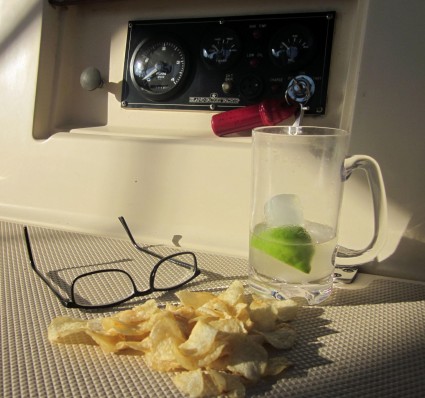
Dear Friends and Family ~
Cocktails (Bob's Passage Notes): The summer of 2011 is over. Officially, it ended a week ago when we were still in Connecticut. And it was a wonderful summer. But for us, unofficially, the summer ended Tuesday night, September 27, at 11:00 PM. That's when we tied up to Chesapeake City's town dock after a 36 hour passage from Port Washington, NY, which took us down the East River and out New York Harbor with the tide pushing us to speeds we do not often attain, along the darkened, fog bound Jersey coast and up Delaware Bay surfing 3 to 5 foot rollers with a 25 kt following breeze. It was the usual long boring semi-annual passage but it was the first time we bypassed a harbor of refuge called Great Kill.
Like the latch on a diamond necklace, Staten Island's Great Kill Harbor connects two parts of a precious circle for us, the circle that includes our southern and northern cruising grounds. Usually, when headed north or south, we stop there to pick up a mooring for a day or two in order to recover from or to prepare for the passage between Long Island Sound and Chesapeake Bay. And while neither of us particularly enjoys the passage, we must make it twice a year in order to accommodate the seasonal modalities of the way of life we have chosen. The fact that wonderful new cruising experiences await at both ends of the passage is a motivating bonus.
Jane and I, in the company of some of the best friends we'll ever enjoy, have been visiting Chesapeake City, MD, for over twenty years. And we always visit The Tap Room when we're there for a great meal in casual surroundings. This visit was no exception to the Tap Room rule. And to make the occasion even more special we were visiting Chesapeake City aboard Voyageur for the first time. After we made ourselves fast to the darkened, empty town dock, we hauled lines for Centime, a Shearwater 39 with Dennis and Heidi aboard who had joined us half way up Delaware Bay. Shortly thereafter we sank into a long, deep sleep that ended late the next morning.
Today, refreshed by our Tap Room feast and hours of deep, restful slumber we motor-sailed twenty miles down Chesapeake Bay to a peaceful, sheltered Sassafras River anchorage. There we watched the sun set over the bow and enjoyed cocktails while Voyageur's anchor settled back into the mud from which we had raised it four months before. Tomorrow we'll move a short distance up the Sassafras to Georgetown and a berth at the Georgetown Yacht Basin where we'll meet with friends Len, Patti, Ron and Carol over the weekend.
Who knows . . . maybe we'll stay the week to properly celebrate the end of summer as we undertake our ceremonial, seasonal switch from Rockporters to Margaritas.
Care to join us ?
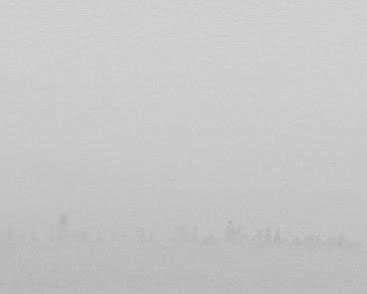
Fog (Jane's Passage Notes): Fog . . . Bob mentioned fog along the New Jersey coast. This was my first "in depth" experience with fog. I know, I know . . . all you New England boaters have lots of experience with fog. But I've never been out in it like we were on this trip.
Coming out of Upper New York Harbor and passing under the Verrazano Narrows Bridge at mid-day we decided to press on for Chesapeake City, MD, in spite of patchy fog on the water. We could see Staten Island but Sandy Hook and Coney Island were hidden from view. So with our vision limited, we turned our attention to the radar overlay on our chart plotter which portrays solid objects (and rain) all around Voyageur out to a distance of 36 miles. Beneath the radar image, the GPS chart plotter displays a map, like the one in your car, but with depths, buoys and hazards and such. In addition, it displays all sorts of other things like distances to waypoints (points on the map you put in), temperatures, both sea and air, barometric pressure, depth, speed through the water and speed over the ground, wind speed and direction (true and apparent) and our latitude and longitude. As Voyageur moves along, the small boat shaped icon in the middle of the chart plotter's screen shows us where we are and where we are going. A dotted line strung out behind the boat symbol even shows us where we've been for the last hundred miles or so.
After a short while, I began to gain confidence in our instruments and what I could deduce from them. As it turned out, they provided all the information we would need to safely navigate the entire fog bound Jersey coast, showing boat traffic and navigational aids moving relative to us or into our path as well as other hazards on and below the surface of the sea. Given the thickness of the fog, it was a bit like closing my eyes for 16 hours and listening to a computer whispering in my ear. I just needed to ask the computer the right questions.
In this regard, a helpful sole recommended to me last year that we travel with our radar on in good weather as well as in bad, even in excellent visibility conditions. That way we could learn how objects such as boats and buoys appear and move on radar and practice using that information. We did so on our trip north this spring, off-shore from St. Augustine to Charleston, on the ICW and around New Jersey and in Long Island Sound. It really was an education and it went a long way toward preparing me for the fog off New Jersey.
Now, when I absolutely needed the radar to be my eyes, I was comfortable interpreting what it was displaying. Though we mingled with quite a few other vessels on the trip, some with better radar images than others, our radar "painted" every one and, even if the vessel was ten or more miles away, we were confident that we knew what direction it was going and at what speed.
Throughout the day and night the fog lifted briefly from time to time but then returned. We always stayed at least five miles off the Jersey coast and, during the night, its lights occasionally came into view such as when the first few floors of Atlantic City's towers appeared, the tops of the buildings being hidden in fog. But a few hours later, when we rounded Cape May only a mile or so off shore, we confidently dodged dangerous shoals by following the bottom contours depicted on our chart plotter and confirmed by our depth sounder. Last spring, with perfect visibility, I was VERY uncomfortable being so close to shore for the rounding. But this time, in spite of hearing the invisible surf, I wasn't (very) concerned.
The day and night we spent in the fog off New Jersey was tiring and occasionally a bit tense. But in the future I'll feel confident traveling, as we hope to, through Block Island Sound, Buzzard's Bay and Maine's Casco and Penobscot Bays . . . all known for fog. On the other hand, there were no lobster pots off New Jersey to worry about. Guess we'll have to wait until next summer to experience that maritime magic.
Bob & Jane Fulton
Sep 2011
Cocktails (Bob's Passage Notes): The summer of 2011 is over. Officially, it ended a week ago when we were still in Connecticut. And it was a wonderful summer. But for us, unofficially, the summer ended Tuesday night, September 27, at 11:00 PM. That's when we tied up to Chesapeake City's town dock after a 36 hour passage from Port Washington, NY, which took us down the East River and out New York Harbor with the tide pushing us to speeds we do not often attain, along the darkened, fog bound Jersey coast and up Delaware Bay surfing 3 to 5 foot rollers with a 25 kt following breeze. It was the usual long boring semi-annual passage but it was the first time we bypassed a harbor of refuge called Great Kill.
Like the latch on a diamond necklace, Staten Island's Great Kill Harbor connects two parts of a precious circle for us, the circle that includes our southern and northern cruising grounds. Usually, when headed north or south, we stop there to pick up a mooring for a day or two in order to recover from or to prepare for the passage between Long Island Sound and Chesapeake Bay. And while neither of us particularly enjoys the passage, we must make it twice a year in order to accommodate the seasonal modalities of the way of life we have chosen. The fact that wonderful new cruising experiences await at both ends of the passage is a motivating bonus.
Jane and I, in the company of some of the best friends we'll ever enjoy, have been visiting Chesapeake City, MD, for over twenty years. And we always visit The Tap Room when we're there for a great meal in casual surroundings. This visit was no exception to the Tap Room rule. And to make the occasion even more special we were visiting Chesapeake City aboard Voyageur for the first time. After we made ourselves fast to the darkened, empty town dock, we hauled lines for Centime, a Shearwater 39 with Dennis and Heidi aboard who had joined us half way up Delaware Bay. Shortly thereafter we sank into a long, deep sleep that ended late the next morning.
Today, refreshed by our Tap Room feast and hours of deep, restful slumber we motor-sailed twenty miles down Chesapeake Bay to a peaceful, sheltered Sassafras River anchorage. There we watched the sun set over the bow and enjoyed cocktails while Voyageur's anchor settled back into the mud from which we had raised it four months before. Tomorrow we'll move a short distance up the Sassafras to Georgetown and a berth at the Georgetown Yacht Basin where we'll meet with friends Len, Patti, Ron and Carol over the weekend.
Who knows . . . maybe we'll stay the week to properly celebrate the end of summer as we undertake our ceremonial, seasonal switch from Rockporters to Margaritas.
Care to join us ?

Fog (Jane's Passage Notes): Fog . . . Bob mentioned fog along the New Jersey coast. This was my first "in depth" experience with fog. I know, I know . . . all you New England boaters have lots of experience with fog. But I've never been out in it like we were on this trip.
Coming out of Upper New York Harbor and passing under the Verrazano Narrows Bridge at mid-day we decided to press on for Chesapeake City, MD, in spite of patchy fog on the water. We could see Staten Island but Sandy Hook and Coney Island were hidden from view. So with our vision limited, we turned our attention to the radar overlay on our chart plotter which portrays solid objects (and rain) all around Voyageur out to a distance of 36 miles. Beneath the radar image, the GPS chart plotter displays a map, like the one in your car, but with depths, buoys and hazards and such. In addition, it displays all sorts of other things like distances to waypoints (points on the map you put in), temperatures, both sea and air, barometric pressure, depth, speed through the water and speed over the ground, wind speed and direction (true and apparent) and our latitude and longitude. As Voyageur moves along, the small boat shaped icon in the middle of the chart plotter's screen shows us where we are and where we are going. A dotted line strung out behind the boat symbol even shows us where we've been for the last hundred miles or so.
After a short while, I began to gain confidence in our instruments and what I could deduce from them. As it turned out, they provided all the information we would need to safely navigate the entire fog bound Jersey coast, showing boat traffic and navigational aids moving relative to us or into our path as well as other hazards on and below the surface of the sea. Given the thickness of the fog, it was a bit like closing my eyes for 16 hours and listening to a computer whispering in my ear. I just needed to ask the computer the right questions.
In this regard, a helpful sole recommended to me last year that we travel with our radar on in good weather as well as in bad, even in excellent visibility conditions. That way we could learn how objects such as boats and buoys appear and move on radar and practice using that information. We did so on our trip north this spring, off-shore from St. Augustine to Charleston, on the ICW and around New Jersey and in Long Island Sound. It really was an education and it went a long way toward preparing me for the fog off New Jersey.
Now, when I absolutely needed the radar to be my eyes, I was comfortable interpreting what it was displaying. Though we mingled with quite a few other vessels on the trip, some with better radar images than others, our radar "painted" every one and, even if the vessel was ten or more miles away, we were confident that we knew what direction it was going and at what speed.
Throughout the day and night the fog lifted briefly from time to time but then returned. We always stayed at least five miles off the Jersey coast and, during the night, its lights occasionally came into view such as when the first few floors of Atlantic City's towers appeared, the tops of the buildings being hidden in fog. But a few hours later, when we rounded Cape May only a mile or so off shore, we confidently dodged dangerous shoals by following the bottom contours depicted on our chart plotter and confirmed by our depth sounder. Last spring, with perfect visibility, I was VERY uncomfortable being so close to shore for the rounding. But this time, in spite of hearing the invisible surf, I wasn't (very) concerned.
The day and night we spent in the fog off New Jersey was tiring and occasionally a bit tense. But in the future I'll feel confident traveling, as we hope to, through Block Island Sound, Buzzard's Bay and Maine's Casco and Penobscot Bays . . . all known for fog. On the other hand, there were no lobster pots off New Jersey to worry about. Guess we'll have to wait until next summer to experience that maritime magic.
Bob & Jane Fulton
Sep 2011
| Vessel Name: | Voyageur |
| Vessel Make/Model: | Island Packet 40 |
| Hailing Port: | Portsmouth, RI |
| Crew: | Bob & Jane Fulton |
| About: | First sail . . . Oshkosh Yacht Club, Lake Winnebago, in 1953 on an M16. First sail together . . . Lake Texoma in 1994 on an ODay 322. We're now full time cruisers aboard our Island Packet 40 cutter Voyageur with cruising friends from Nova Scotia to the Bahamas. It's what cruising is all about. |
| Extra: | DAS BOAT ~ LOA - 41'6" Beam - 12'11'' Displ - 22,800lb Sail Area - 907 sq ft 2 Staterooms; 2 Heads |
Voyageur's Photos - Main
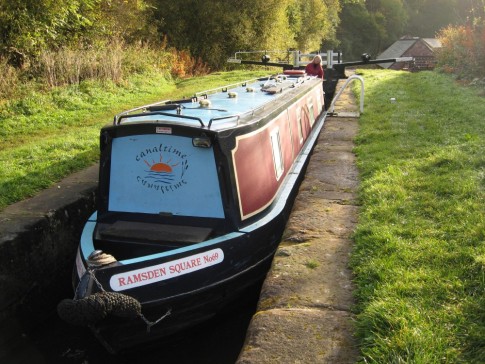 |
We leave Voyageur in St. Augustine and return to the canals and locks of the United Kingdom for our third narrowboat cruise.
56 Photos
Created 24 November 2009
|
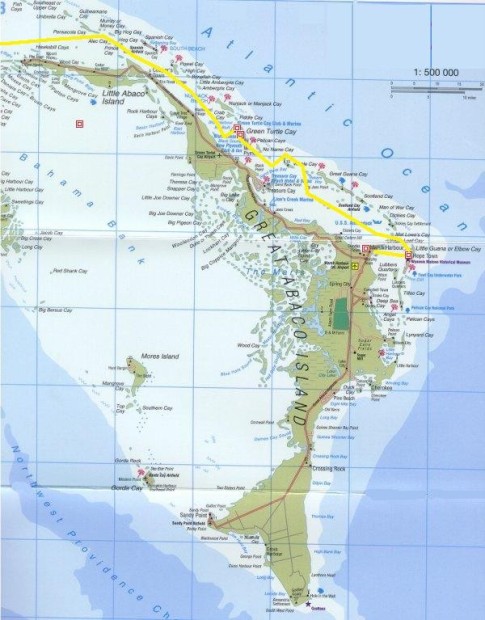 |
The Abacos are the islands and cays that comprise the Northern Bahamas.
46 Photos
Created 23 April 2009
|
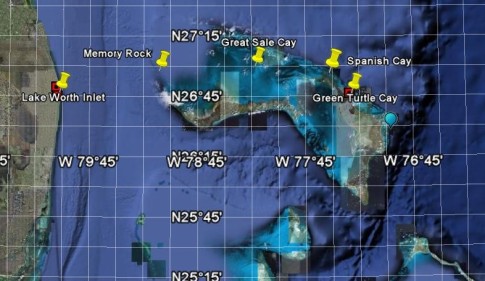 |
From Lake Worth (West palm Beach), we set out across the Gulf Stream bound for the Little Bahama Bank and Great Sale Cay on our way to the Abacos.
16 Photos
Created 23 April 2009
|
 |
From St. Augustine, we head further South for Lake Worth, near West Palm Beach, a popular jumping off point for the Bahamas . . . Mile 776 to Mile 1014
45 Photos
Created 10 March 2009
|
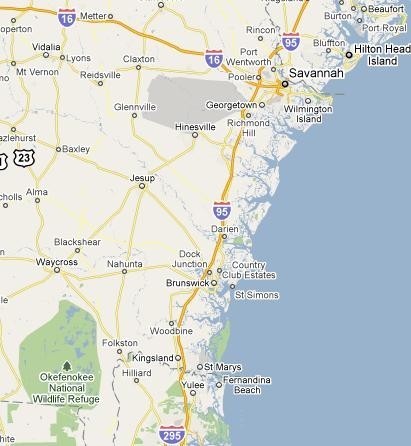 |
Joined by Bobby and Starr, we point the bow South once again in search of warm breezes and Florida sunshine . . . Mile 563 to Mile 716
22 Photos
Created 20 February 2009
|
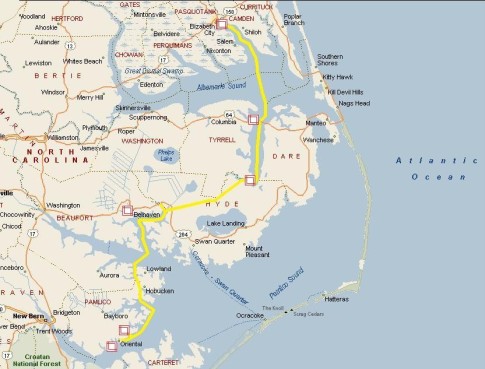 |
On November 17 we begin following rivers and crossing sounds on our way South to Oriental, NC . . . Mile 51 to Mile 181
11 Photos
Created 19 February 2009
|
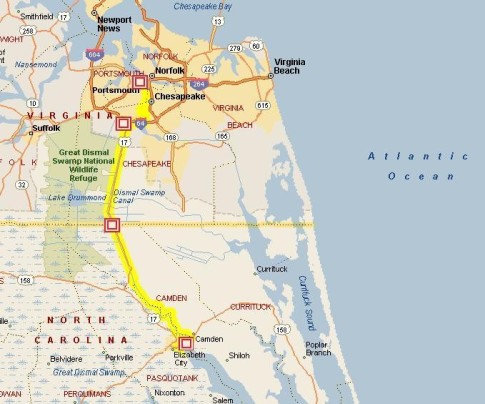 |
Our first "official" leg on the Intracoastal Waterway . . . Mile 0 to Mile 51
25 Photos
Created 18 February 2009
|
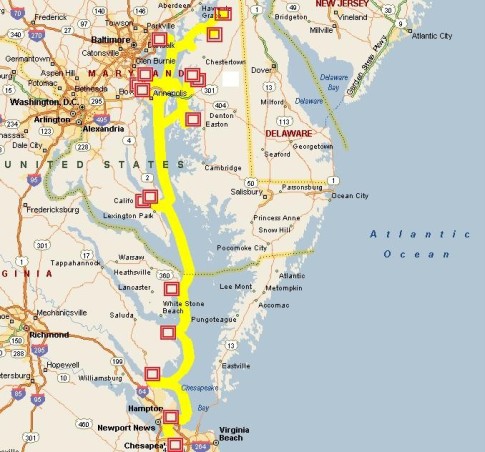 |
While we spent the month of October on this magnificent body of water , winter caught up to us.
19 Photos
Created 13 February 2009
|
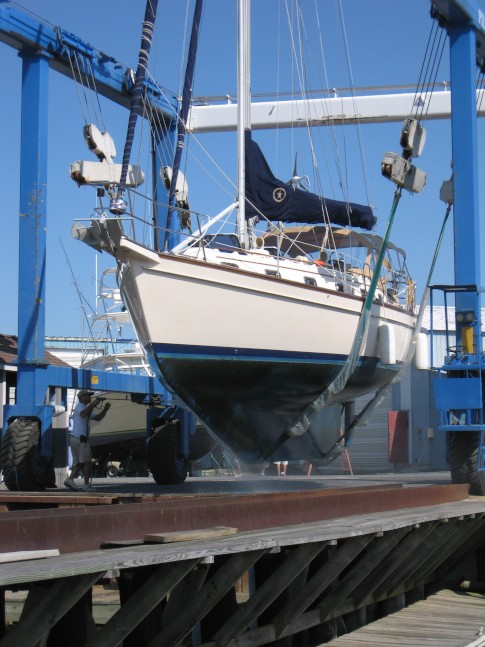 |
Getting ready to cast off, we sell most of our land life things and move aboard.
8 Photos
Created 27 September 2008
|
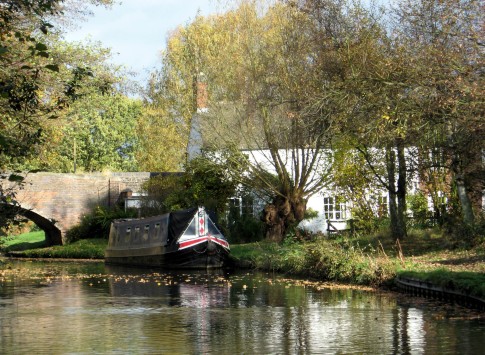 |
Exploring the canal and lock system in England and Wales with friends Bobby & Starr, we discuss our cruising dreams.
8 Photos
Created 5 July 2008
|
Welcome Aboard Voyageur
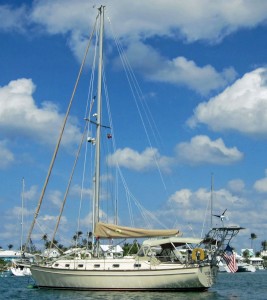
Who: Bob & Jane Fulton
Port: Portsmouth, RI
